Table of contents
- Schnell-Horex 250 from the post-war period dohc self-made by Roland Schnell
- Three single-cylinder prototypes for 1952
- Hard chrome coating on racing engines
- Many technical features
- The motor-gear unit works like a block motor
- His construction quickly lands on the podium
- More than a dozen pilots counted on the Schnell-Horex in 1953
- The days of Schnell single-cylinder seem numbered
- In 1955 Schnell KG is deleted from the commercial register
- Data Schnell-Horex 250 *
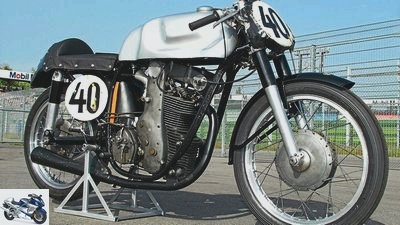
Noll
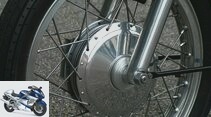
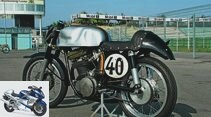

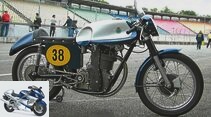
21 pictures
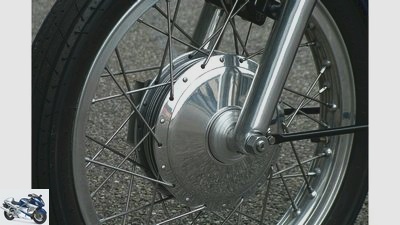
Noll
1/21
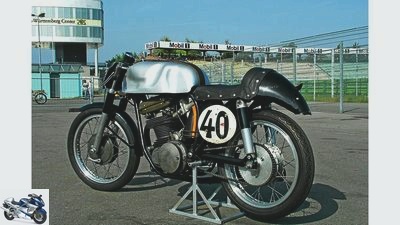
Noll
2/21
The 250 quick Horex shown here was sold to Georg Braun in 1953. Due to his good results – on the previous year’s construction he was at least third-best private driver – he received the 350 double-cam twin-cylinder from Horex for the following season in 1954.

Noll
3/21
The Schnell-Horex gearbox wheel sets, housing cover and automatic gearshift came from a pre-war DKW SS 250. However, due to lack of space, the manufacture of a new gearbox housing was inevitable. The primary drive was via spur gears.

Noll
4/21
This half-liter Schnell-Horex was superbly restored by Horex collector Rolf Dachs. It comes from the 1953 series and already has the new four-speed transmission from Getrag. At that time it was one of the fastest racing machines on the market.

Noll
5/21
The Bosch ignition magnet is located behind the cylinder, where it is well protected from splashing water.
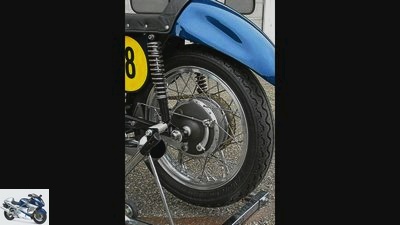
Noll
6/21
The rear wheel axle is mounted in an eccentric, which practically prevents the wheel from tilting when the chain is tensioned.

archive
7/21
Nurburgring on May 23, 1953: Georg Braun on Schnell-Horex 500, which here is equipped with a new swing fork. His starting position in the first row underlines the capabilities of the driver and the machine.
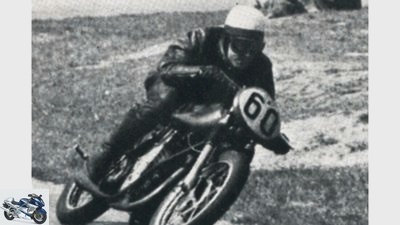
archive
8/21
Fritz Klager, who competes the season with a 350 Schnell-Horex, can also achieve some successes …
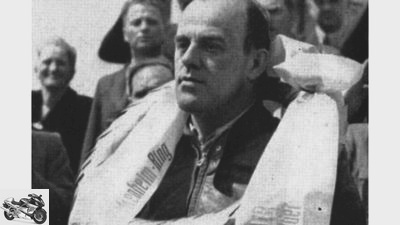
archive
9/21
… In the first race on the Dieburger triangular course, he brought his Horex to the finish in second place behind his fellow brand colleague Muller. He, in turn, is the best private 350cc driver at the end of the season.
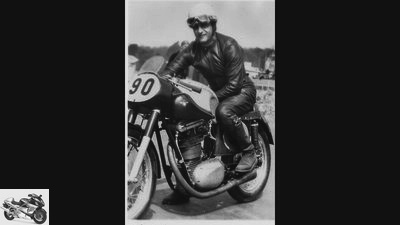
archive
10/21
Old master H.P. Muller, a factory driver at Horex in 1953, can only use the new factory twin occasionally. At the same time, he also drives a Schnell-Horex, making it the best private driver in 1953.
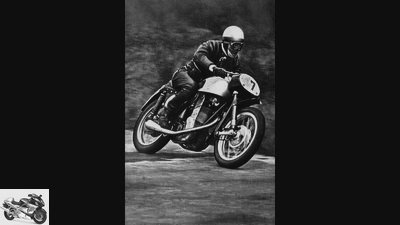
archive
11/21
In 1953 Braun drove an excellent race at the Nurburgring, was able to leave several BMWs and Nortons behind and finished second with the 500 cc single-cylinder engine.

archive
12/21
After the successes of the previous year, many racing drivers started on Schnell-Horex in 1953. Right at the front here Fritz Klager (# 60) in Dieburg.
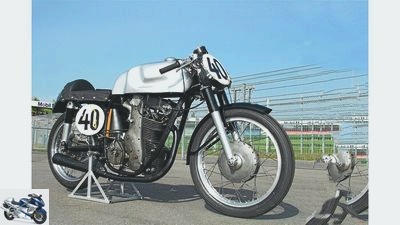
Noll
13/21
The 250 quick Horex is a one-off. With her, the Karlsruhe Hermann Gablenz became German runner-up in 1952.
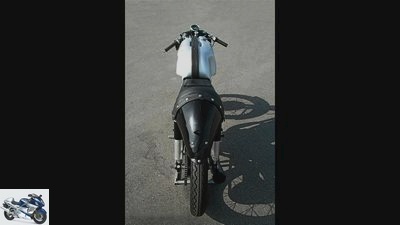
Noll
14/21
The rear fairing originally used was discarded on the 250 as part of constant improvements.
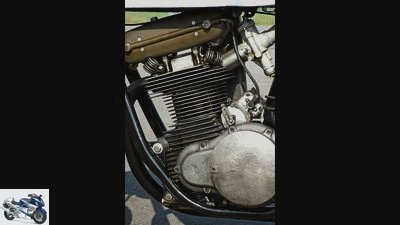
Noll
15/21
The 250 engine with a square bore / stroke ratio of 68 mm develops around 28 hp at 8500 rpm. The completely ribbed motor housing is made of magnesium. Four long tie rods, which even run through the lower half of the engine housing, hold the individual assemblies, including the cylinder and double-cam cylinder head, together.

Noll
16/21
A chain drives the exhaust camshaft of the distinctive dohc single cylinder. The thin frame tubes were not up to the performance, they had to be reinforced later.
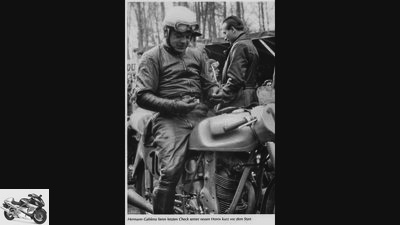
archive
17/21
Hermann Gablenz, the German champion from 1950, starts two years later on the 250 Schnell-Horex, here observed by the designer Roland Schnell (in a leather coat).
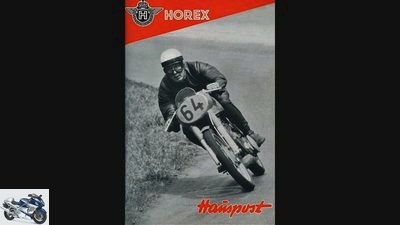
archive
18/21
Fast on fast: The man from Karlsruhe gets along best with the machine in the 1952 season. With its reliable new design, it becomes the 350 master …
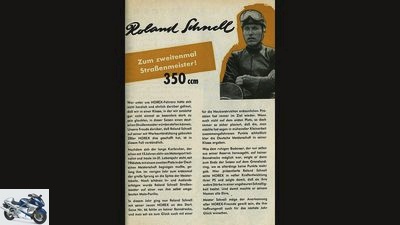
archive
19/21
… There are words of praise from the Horex works in the “in-house mail”.
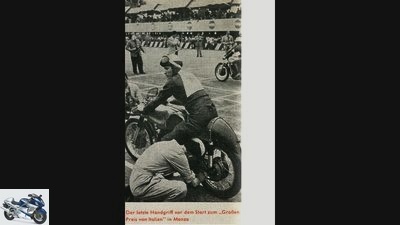
archive
20/21
Roland Schnell with the 350 at the start of the Italian Grand Prix in the park of Monza.
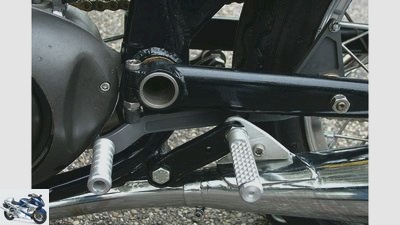
Noll
21/21
counselor
workshop
Schnell-Horex 250 dohc self-made by Roland Schnell
Schnell-Horex 250 from the post-war period
dohc self-made by Roland Schnell
Content of
At the beginning of the 1950s, Germany was allowed to participate in international motorsport again. BMW, DKW, NSU and Horex develop new racers for their works drivers. Private drivers who want to start with a German make, however, look into the tube. Until Roland Schnell offered them his dohc self-made products in 1953.
Jurgen Noell
02/20/2014
Good racing machines are in short supply in the first post-war years. What is left of the war is taken. The two Karlsruhe racing drivers Roland Schnell and Hermann Gablenz are different: in 1949 they acquire two of the Parilla “Speziale Corsa”, which have only just appeared on the market, and optimize the machines according to their own ideas. Hermann Gablenz receives the 250, his friend Roland Schnell the 350.
Buy complete article
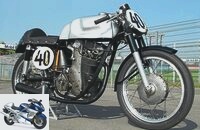
Schnell-Horex 250 from the post-war period
dohc self-made by Roland Schnell
8 pages) as PDF
€ 2.00
Buy now
Gablenz clinched the first victory at the Schleizer triangle race. This should not be a chance hit, which he proves with his triumph at the Sachsenring. In the 1950 season he won the German motorcycle championship with five victories in the compressorless quarter-liter machines. At Roland Schnell, on the other hand, the constant improvements to his Parilla only paid off in 1951, which has meanwhile blossomed into the fastest motorcycle in the 350 class. With five first places he is also German champion. Then the bold plan of a self-made racing machine matures in the minds of the two friends. The construction should be designed in such a way that racing machines with displacement classes from 250 to 500 cm³ could be built on its basis.
Three single-cylinder prototypes for 1952
When Horex dealer Gablenz reports on the idea in Bad Homburg, Horex boss Fritz Kleemann signals interest. Even if the factory is currently working intensively on the 500 race wins, a small series of commercially available racing machines still seems to be a welcome asset to him, as it would strengthen the local makes over the leading production racers from AJS, Moto Guzzi, Norton and Velocette. In return for financial support and the delivery of parts such as forks or brakes, Schnell should use the brand name Horex place on the tank.
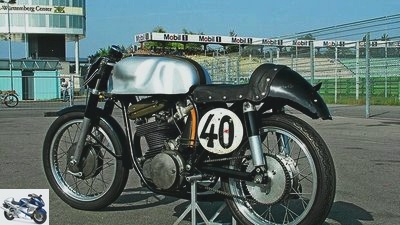
Noll, Jurgen
250 quick Horex.
As early as issue 7/1952, MOTORRAD reported “that a single-cylinder racing type of 250, 350 and 500 cm³ was created that cannot be compared with any known model. If this construction works, and that can be assumed, then there is hope for later that even more private drivers will drive this ‘Extra’ Horex. “
Because Roland Schnell had made a name for himself primarily as a designer and manufacturer of chassis in the past few years, his engine design was all the more surprising. Although borrowings from the AJS, Norton and Parilla engines that have been used so far can be seen here and there in his engine, the concept is new. For example, the use of magnesium as a material for the motor housing corresponds to his preference for lightweight construction, although aluminum housings are also used for the later models. In the early 1950s, the horizontally split crankcase with cooling fins and stiffeners was absolutely unusual. Four long tie rods, which even run through the lower half of the engine housing, hold the individual assemblies, including the cylinder and double-cam cylinder head, together.
The two crank disks, crank pins and bearing pins of the crankshaft are pressed together. Due to the small number of units produced between 1952 and 1954, almost every engine is a one-off production. This applies not only to the different length strokes of the three displacement classes offered, but also to the design of the crankshafts. The cylinder dimensions of the 350s changed between 1952 and 1953. In the case of the half-liter engine, of which no more than six units are produced with a bore of 85 millimeters and a stroke of 88 millimeters, the left drive side consistently uses wider and larger-diameter lifting disks. Of course, improvements that have been tried and tested in racing are also permanently incorporated into the current small series. Thus, among other things, the initial rolling and twisting of the steel bushes used to hold the crankshaft bearings is counteracted by a corresponding fixation, which Schnell realized using dowel pins.
Hard chrome coating on racing engines
In the years before the Second World War, Norton already had aluminum cylinders with pressed-in cylinder liners made of gray cast iron. At the Stuttgart piston manufacturer Mahle, intensive tests were carried out at the beginning of the 1950s, with these heavy-weight cast liners being replaced by special hard chrome coatings. As early as 1951, this process can successfully go into series production in the air-cooled 1.3-liter boxer engines from Porsche. When Roland Schnell became aware of this new type of technology, he also used the hard chrome coating on his racing engines.
Schnell is also doing away with the valve seat inserts that were customary up to that point from Porsche by achieving an almost equally high level of wear resistance through appropriate material compression on its aluminum cylinder heads. What works without any problems with the Porsche engines in series production, however, does not work optimally in racing. Above all, the thermally highly stressed exhaust valves sink in early and force frequent readjustments of the valves.
Many technical features
In addition to the strong ribbing, the extremely long shafts on the right-hand side of the engine for accommodating the timing chain are noticeable on Roland Schnell’s single cylinders. A spur gear on the crankshaft drives the chain pinion on the common shaft via an intermediate gear. From here a single roller chain leads up to the inlet camshaft. At the same time, this chain also drives the Bosch ignition magnet located behind the cylinder.
A total of four spur gears located on the left side of the engine in the camshaft housing drive the exhaust camshaft. The even number of spur gears results in different directions of rotation for the two camshafts. Only in the early single-cylinder models is a roller chain used to drive the exhaust camshaft. The timing is adjusted using so-called vernier connections, in which the gears of the camshafts can be fixed in different positions on the shaft with pins. The valve tappets are sealed by shaft sealing rings, and the unencapsulated hairpin valve springs can be easily replaced if the spring breaks.
A Dellorto SSI racing carburetor takes care of the mixture preparation, while an oil pump equipped with two pairs of gears supplies the engine with lubricant. The oil tank is located under the seat, while the oil pump is deep in the engine housing. It is driven directly from the crankshaft by means of spur gears.
The motor-gear unit works like a block motor
When installed, the Schnell-Horex’s motor-gear unit works like a block motor. In fact, however, the motor and gearbox are housed in separate housings that are bolted together. In order to keep the constructive effort within limits, Roland Schnell first tried to use an “off the shelf” gearbox. With the help of ex-DKW racing driver Hermann Gablenz, three complete racing transmissions of the DKW SS 250 with suitable gearshifts can be procured via old connections to the DKW racing department in Zschopau. The four gears of the reverse gear are geared 2.16 – 1.51 – 1.20 and 1.0.
The gear sets and housing covers as well as the automatic switchgear can actually be taken over, but for reasons of space, the manufacture of new gearboxes is inevitable. The drive in the form of two straight toothed spur gears is housed together with the dry clutch in a light metal housing on the left side of the machine. Motorcycles with these first transmission variants can be easily recognized by the secondary chain on the left side of the vehicle. From 1953, the company Getrag, based in Ludwigsburg, supplies a small series of four-speed racing transmissions with a ratio of 1.938 – 1.40 – 1.136 and 1.0 and also has a spur gear drive. In these variants, the chain to the rear wheel is on the right-hand side of the vehicle.
At the start of the 1952 season, there were two prototypes at the start of the Dieburger Dreiecksrennen for the first time. To the great surprise, Gablenz already took second place with the 250 when the new design made its debut. But already at the international Rhine Cup race in Hockenheim it is clear that the engines are much more powerful than the ultra-light chassis can handle. Schnell and Gablenz have an impressive speed, but the machines wobble frighteningly.
His construction quickly lands on the podium
So much so that Roland Schnell even has to turn off his 350 for safety reasons. On the other hand, things are going much better at the Eifel race on the Nurburgring-Nordschleife. Although Gablenz can’t get past Thorn-Prikker again and has to be content with fourth place behind his quarter-liter Moto Guzzi, Roland Schnell is right at the front on the 350 cc. After Baltisberger on AJS and Knees on Norton, Schnell crossed the finish line in third place and stood on the podium for the first time since he started using his own construction. After the Feldberg race, both single-cylinder Horex are in fifth place in the championship standings with five points each. In the 350 cc it is by far the best German machine, in the 250 cc it is the DKW of works driver Ewald Kluge in second place.
At the Eilenriede race on June 29th in the city forest of Hanover, Schnell managed to leave the machines from AJS and Norton behind for the first time, and behind the DKW works drivers Kluge and Siegfried “Sissi” wishes on their fast three-cylinder machines with a remarkable third place to secure important points in the battle for the championship. At the end of the season, Roland Schnell actually made it: He wins the German championship in the 350cc class and can thus successfully defend his championship title from the previous year. In the 1952 season, Gablenz was runner-up in the quarter-liter class.
More than a dozen pilots counted on the Schnell-Horex in 1953
These successes are paying off: at the end of the successful testing phase, numerous orders have been placed for the following season. On January 1, 1953, Roland Schnell-Motoren KG began operations in Karlsruhe. According to press reports, well-known German racing drivers, including Fritz Klager, Friedel Schon, H.P. Muller, Robert Zeller, Karl Ruhrschneck, Siegfried Fub, Hugo Schmitz and Friedrich Hillebrand, ordered their machines for the new season.

Noll, Jurgen
Hermann Gablenz, the German champion from 1950, starts two years later on the 250 Schnell-Horex, here observed by the designer Roland Schnell (in a leather coat).
Other customers are Aldinger, Duthe, Bahr, Beer, Baun, the Swiss Gerber, the French Emo and the Saarland Lang. The Baden-Badener Fub will also get a 500 solo machine, while the Amberg Hillebrand will have a 500 for use in the sidecar class. Schnell also plans to supply half-liter engines for Formula 3 racing cars, since the use of motorcycle engines (BMW, Norton, Gilera, Zundapp) is very popular here too. The engine output is given for the 350 (bore / stroke 75 x 79 mm) with 35 HP at 8000 / min, the 500 (bore / stroke 85 x 88 mm) should create 45 HP at 7500 / min. The 250 from the previous year should therefore have had around 28 hp.
In the 1953 racing season, more than a dozen pilots put their trust in the reliability and performance of a Schnell-Horex, with old master Hermann-Paul Muller achieving the greatest successes. As a private driver, he starts with the 350s, while he is under contract with Horex as a works driver for a half-liter two-cylinder machine. However, since the twin does not really get up and running, it occasionally goes to the start with the 500 single-cylinder engine from Schnell.
Gablenz has meanwhile announced his retirement from active racing and sold his 250cc Schnell-Horex to the young, promising young driver Georg Braun from Hechingen. The season started again in 1953 at the Dieburger Dreiecksrennen. There are so many entries in the 350 class that the organizer cannot accept all private drivers.
Until 1952, with the exception of the prototype driven by Schnell and a Moto Parilla, the English AJS, Norton and Velocettes were among themselves, now this first commercially available German racing machine dominates numerically. But what is even more surprising: the newcomer is able to show all English singles the exhaust pipe right from the start. Two of the fast racers were the first to cross the finish line: H. P. Muller won after 20 laps and a race distance of 100 kilometers with an average of 121.4 km / h in front of his brand colleague Fritz Klager. Muller completed his fastest lap with an average speed of 124.9 km / h, set a new lap record and took almost a whole lap from the rest of the field. But against the German factory competitors in the further course of the 53 season there was no herb. Neither against the newly developed 250 NSU Rennmax nor against the “Singing Saws” from DKW with their three-cylinder two-stroke engines. So the private drivers deliver their own races.
The days of Schnell single-cylinder seem numbered
At the season finale on the Eilenriede, “HaPe” finally secured the title of best 350 private driver in 1953 with his Horex. On top of that, Muller succeeds in referring Schon to Norton and Klager to Gilera in the course of the 500s. With an average speed of 130.5 km / h, he only has to let “Schorsch” Meier pull the factory BMW after he was initially able to keep up with its speed.
Still, the days of Roland Schnells single-cylinder seem numbered. At least when it comes to top placements in races with international participation. One of the latest developments by Roland Schnell KG, which from 1954 onwards kept afloat with Regina conversion kits on long-arm swinging forks, was a half-liter racing machine with a single-cylinder engine that was installed at a steep incline. Based on the recumbent single-cylinder from Moto Guzzi, Schnell tries to improve road holding by lowering the center of gravity. As H.P. Muller first appeared at the Bern Grand Prix at the end of August 1953 with this fully encased machine, he amazed the professional world. Similar to the Guzzi factory racers, Schnell has stored the fuel in tanks on both sides in the lower area of the fairing, which also lowered the center of gravity.
In 1955 Schnell KG is deleted from the commercial register
Even in practice, Muller surprises with lap times that are only marginally behind those of the fastest. And in the race he can keep up with the pace of the leaders before he ultimately retires. A little later, at the World Championship round in Monza, Italy, Muller actually managed a fastest time in practice among all the four-cylinder engines from Gilera and MV Agusta, but had to give up again in the race due to a technical defect. Was that the right approach? The improvement in handling and the aerodynamic full fairing made it possible to at least partially compensate for the increased performance of the competition?
Perhaps. But money will soon run out for the necessary further development of the Schnell-Horex. Especially since customer interest in motorcycles and thus also in racing machines is declining significantly. Norton and Matchless have now thoroughly revised their commercially available racing machines, which have more power and excellent chassis. In addition, another commercial racer made in Germany has been announced for the 1954 season: the new BMW 500 RS. At the IFMA in Frankfurt in late autumn 1953, Schnell-Horex can no longer be seen. In October 1955 Schnell KG is deleted from the commercial register of the city of Karlsruhe. The machines that are still in use – like all racing machines without further development – lose more and more importance over the years.
After a long stay abroad, designer Roland Schnell died on October 8, 1980 in his hometown of Karlsruhe at the age of only 59. There is no longer any precise information about the number of Schnell-Horex built. It is assumed, however, that there was only one 250, which was initially driven by Gablenz and from 1953 by Braun. Five to six of the half-liter machines are likely to have been made, with the 350 making up the largest proportion with eight copies.
Data Schnell-Horex 250 *
Engine: Air-cooled single-cylinder four-stroke engine, two overhead camshafts, two valves, bore / stroke 68 x 68 mm (75 x 79/85 x 88 mm), displacement: 250 cm³ (350/500 cm³), compression 9.8: 1, Output 28 hp at 8500 rpm (35 hp at 8000 rpm / 45 hp at 7500 rpm), dry sump lubrication, Bosch magneto ignition, Dellorto SSI carburetor, Ø 35 mm (35/40 mm), dry sump lubrication
Power transmission: multi-disc dry clutch, claw-shift four-speed gearbox from DKW SS 250 (350/500: Getrag), primary drive via chain, from 1953 via spur gears
Chassis: double-loop tubular frame, front fork from Horex Regina, two-arm swing arm with two spring struts, full-hub brakes front and rear, wire-spoke wheels, tires 3.25-19 front and 3.50-18 rear. Construction period: 1952–1953
* 350 and 500 in brackets
Related articles
-
In the studio: CZ 250 dohc prototype
www.bilski-fotografie.de 25th pictures www.bilski-fotografie.de 1/25 CZ 250 dohc prototype. www.bilski-fotografie.de 2/25 CZ 250 dohc prototype….
-
Noll 14th pictures Noll 1/14 The restoration of the successful Horex team from 1935. The racing machine gets a general overhaul. Noll 2/14 The…
-
Police stop 14-year-olds on self-made bikes
Rotenburg police counselor traffic & business Police stop 14-year-olds on self-made bikes Police stop 14-year-olds on self-made bikes Super scarifier…
-
Driving report Brough Superior S.P. 100
Kyoichi Nakamura motorcycles Driving report Brough Superior S.P. 100 Driving report Brough Superior S.P. 100 Rebirth A legend has resurrected: the famous…
-
archive Sports & scene Obituary Arturo Magni Obituary Arturo Magni World champion mechanic Arturo Magni died on December 2, 2015 at the age of 90. From…
-
Schwab Sports & scene History of motorcycle tuning History of motorcycle tuning Tuners have never had it harder Content of About 50 years ago, motorcycle…
-
Roland Sands classic conversion of a KTM 790 Adventure
rolandsands.com 12th pictures rolandsands.com 1/12 A customer would like to drive a brand new KTM 790 Adventure, but please have it come with a classic…
-
PS-TuneUp Triumph Daytona 675 race track tuning
Feulner 17th pictures Andreas Feulner 1/17 PS-TuneUp has set itself the task of forging a good racing athlete into a hot race track sweeper with the…
-
IDM Superbike 1000 De Boer rides for Yamaha MGM
Danny de Boer Sports & scene Motorsport IDM Superbike 1000 De Boer rides for Yamaha MGM IDM Superbike 1000 De Boer is Yamaha’s hope It has long been…
-
The engines of the 500th Moto Cross World Championship
counselor technology & future The engines of the 500th Moto Cross World Championship The engines of the 500th Moto Cross World Championship To each his…